An Analysis of Gender Discrimination in Organizational Settings
VerifiedAdded on 2022/08/08
|7
|1494
|23
Essay
AI Summary
This essay examines the pervasive issue of gender discrimination in organizations, focusing on the underrepresentation of women in managerial positions. It presents arguments from various researchers and organizational analysts, highlighting the disparity in leadership roles and the challenges women face in career advancement. The essay compares opinions, presenting viewpoints that highlight the gender disparity, such as the under-representation of women in top positions and limited promotion opportunities, as well as opinions that deny the disparity, citing increases in women's representation at organizations and at the managerial level, also mentioning that women may not be suited to be bosses. The conclusion emphasizes the persistent issues despite societal progress and the ongoing efforts of the international women’s movement to mitigate workplace gender disparities. The essay provides a detailed analysis of the topic, supported by references to relevant studies and reports.
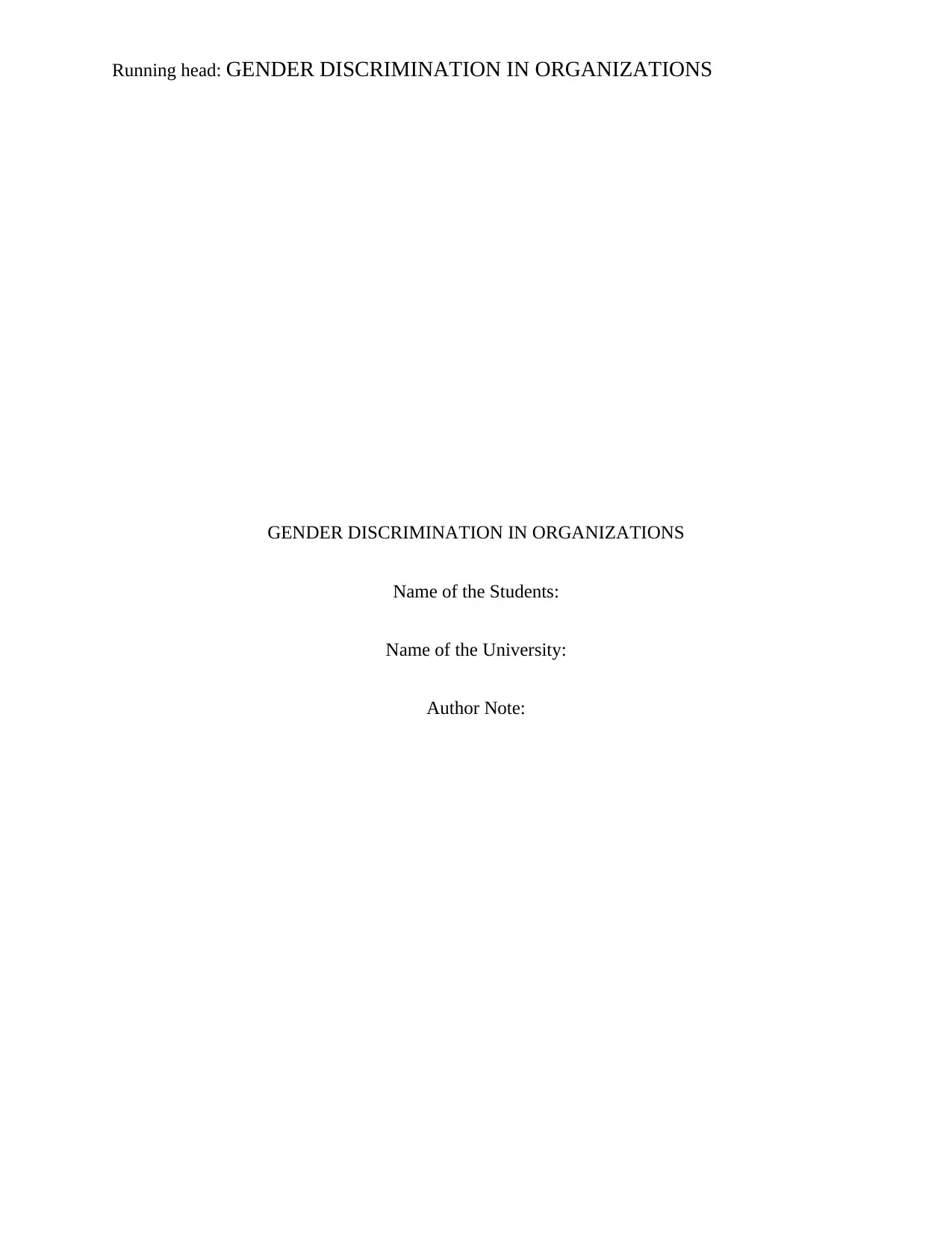
Running head: GENDER DISCRIMINATION IN ORGANIZATIONS
GENDER DISCRIMINATION IN ORGANIZATIONS
Name of the Students:
Name of the University:
Author Note:
GENDER DISCRIMINATION IN ORGANIZATIONS
Name of the Students:
Name of the University:
Author Note:
Paraphrase This Document
Need a fresh take? Get an instant paraphrase of this document with our AI Paraphraser
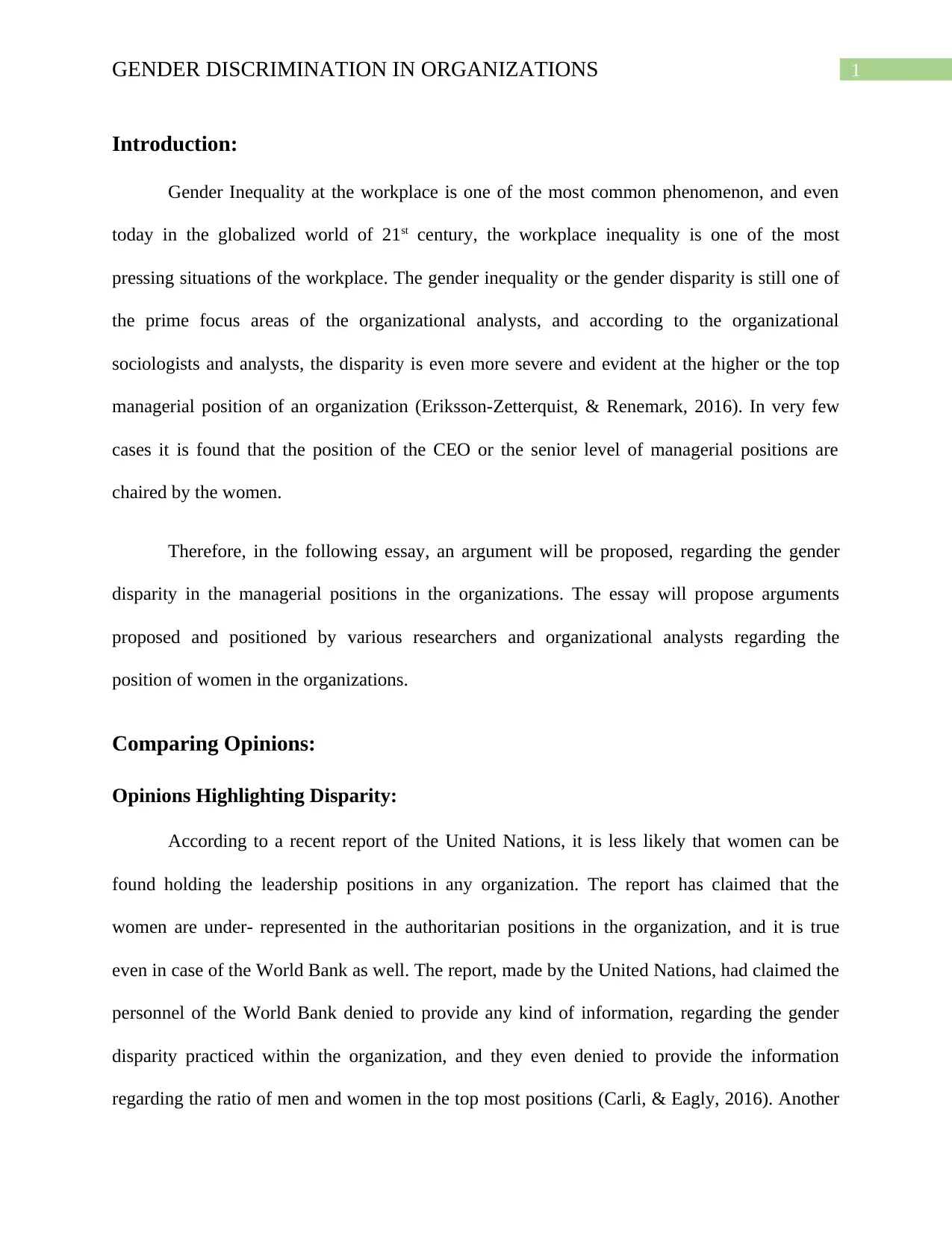
1GENDER DISCRIMINATION IN ORGANIZATIONS
Introduction:
Gender Inequality at the workplace is one of the most common phenomenon, and even
today in the globalized world of 21st century, the workplace inequality is one of the most
pressing situations of the workplace. The gender inequality or the gender disparity is still one of
the prime focus areas of the organizational analysts, and according to the organizational
sociologists and analysts, the disparity is even more severe and evident at the higher or the top
managerial position of an organization (Eriksson‐Zetterquist, & Renemark, 2016). In very few
cases it is found that the position of the CEO or the senior level of managerial positions are
chaired by the women.
Therefore, in the following essay, an argument will be proposed, regarding the gender
disparity in the managerial positions in the organizations. The essay will propose arguments
proposed and positioned by various researchers and organizational analysts regarding the
position of women in the organizations.
Comparing Opinions:
Opinions Highlighting Disparity:
According to a recent report of the United Nations, it is less likely that women can be
found holding the leadership positions in any organization. The report has claimed that the
women are under- represented in the authoritarian positions in the organization, and it is true
even in case of the World Bank as well. The report, made by the United Nations, had claimed the
personnel of the World Bank denied to provide any kind of information, regarding the gender
disparity practiced within the organization, and they even denied to provide the information
regarding the ratio of men and women in the top most positions (Carli, & Eagly, 2016). Another
Introduction:
Gender Inequality at the workplace is one of the most common phenomenon, and even
today in the globalized world of 21st century, the workplace inequality is one of the most
pressing situations of the workplace. The gender inequality or the gender disparity is still one of
the prime focus areas of the organizational analysts, and according to the organizational
sociologists and analysts, the disparity is even more severe and evident at the higher or the top
managerial position of an organization (Eriksson‐Zetterquist, & Renemark, 2016). In very few
cases it is found that the position of the CEO or the senior level of managerial positions are
chaired by the women.
Therefore, in the following essay, an argument will be proposed, regarding the gender
disparity in the managerial positions in the organizations. The essay will propose arguments
proposed and positioned by various researchers and organizational analysts regarding the
position of women in the organizations.
Comparing Opinions:
Opinions Highlighting Disparity:
According to a recent report of the United Nations, it is less likely that women can be
found holding the leadership positions in any organization. The report has claimed that the
women are under- represented in the authoritarian positions in the organization, and it is true
even in case of the World Bank as well. The report, made by the United Nations, had claimed the
personnel of the World Bank denied to provide any kind of information, regarding the gender
disparity practiced within the organization, and they even denied to provide the information
regarding the ratio of men and women in the top most positions (Carli, & Eagly, 2016). Another
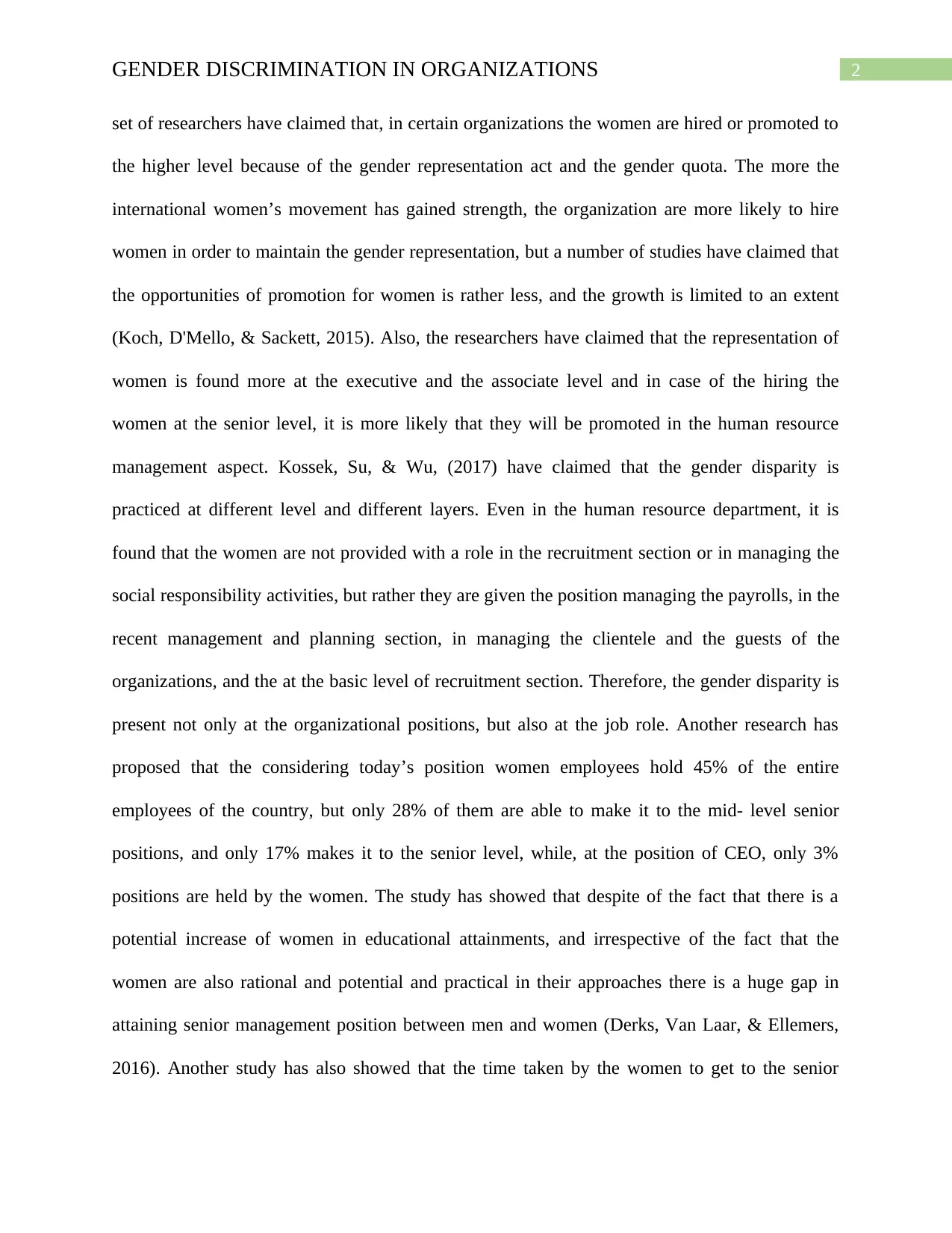
2GENDER DISCRIMINATION IN ORGANIZATIONS
set of researchers have claimed that, in certain organizations the women are hired or promoted to
the higher level because of the gender representation act and the gender quota. The more the
international women’s movement has gained strength, the organization are more likely to hire
women in order to maintain the gender representation, but a number of studies have claimed that
the opportunities of promotion for women is rather less, and the growth is limited to an extent
(Koch, D'Mello, & Sackett, 2015). Also, the researchers have claimed that the representation of
women is found more at the executive and the associate level and in case of the hiring the
women at the senior level, it is more likely that they will be promoted in the human resource
management aspect. Kossek, Su, & Wu, (2017) have claimed that the gender disparity is
practiced at different level and different layers. Even in the human resource department, it is
found that the women are not provided with a role in the recruitment section or in managing the
social responsibility activities, but rather they are given the position managing the payrolls, in the
recent management and planning section, in managing the clientele and the guests of the
organizations, and the at the basic level of recruitment section. Therefore, the gender disparity is
present not only at the organizational positions, but also at the job role. Another research has
proposed that the considering today’s position women employees hold 45% of the entire
employees of the country, but only 28% of them are able to make it to the mid- level senior
positions, and only 17% makes it to the senior level, while, at the position of CEO, only 3%
positions are held by the women. The study has showed that despite of the fact that there is a
potential increase of women in educational attainments, and irrespective of the fact that the
women are also rational and potential and practical in their approaches there is a huge gap in
attaining senior management position between men and women (Derks, Van Laar, & Ellemers,
2016). Another study has also showed that the time taken by the women to get to the senior
set of researchers have claimed that, in certain organizations the women are hired or promoted to
the higher level because of the gender representation act and the gender quota. The more the
international women’s movement has gained strength, the organization are more likely to hire
women in order to maintain the gender representation, but a number of studies have claimed that
the opportunities of promotion for women is rather less, and the growth is limited to an extent
(Koch, D'Mello, & Sackett, 2015). Also, the researchers have claimed that the representation of
women is found more at the executive and the associate level and in case of the hiring the
women at the senior level, it is more likely that they will be promoted in the human resource
management aspect. Kossek, Su, & Wu, (2017) have claimed that the gender disparity is
practiced at different level and different layers. Even in the human resource department, it is
found that the women are not provided with a role in the recruitment section or in managing the
social responsibility activities, but rather they are given the position managing the payrolls, in the
recent management and planning section, in managing the clientele and the guests of the
organizations, and the at the basic level of recruitment section. Therefore, the gender disparity is
present not only at the organizational positions, but also at the job role. Another research has
proposed that the considering today’s position women employees hold 45% of the entire
employees of the country, but only 28% of them are able to make it to the mid- level senior
positions, and only 17% makes it to the senior level, while, at the position of CEO, only 3%
positions are held by the women. The study has showed that despite of the fact that there is a
potential increase of women in educational attainments, and irrespective of the fact that the
women are also rational and potential and practical in their approaches there is a huge gap in
attaining senior management position between men and women (Derks, Van Laar, & Ellemers,
2016). Another study has also showed that the time taken by the women to get to the senior
⊘ This is a preview!⊘
Do you want full access?
Subscribe today to unlock all pages.

Trusted by 1+ million students worldwide
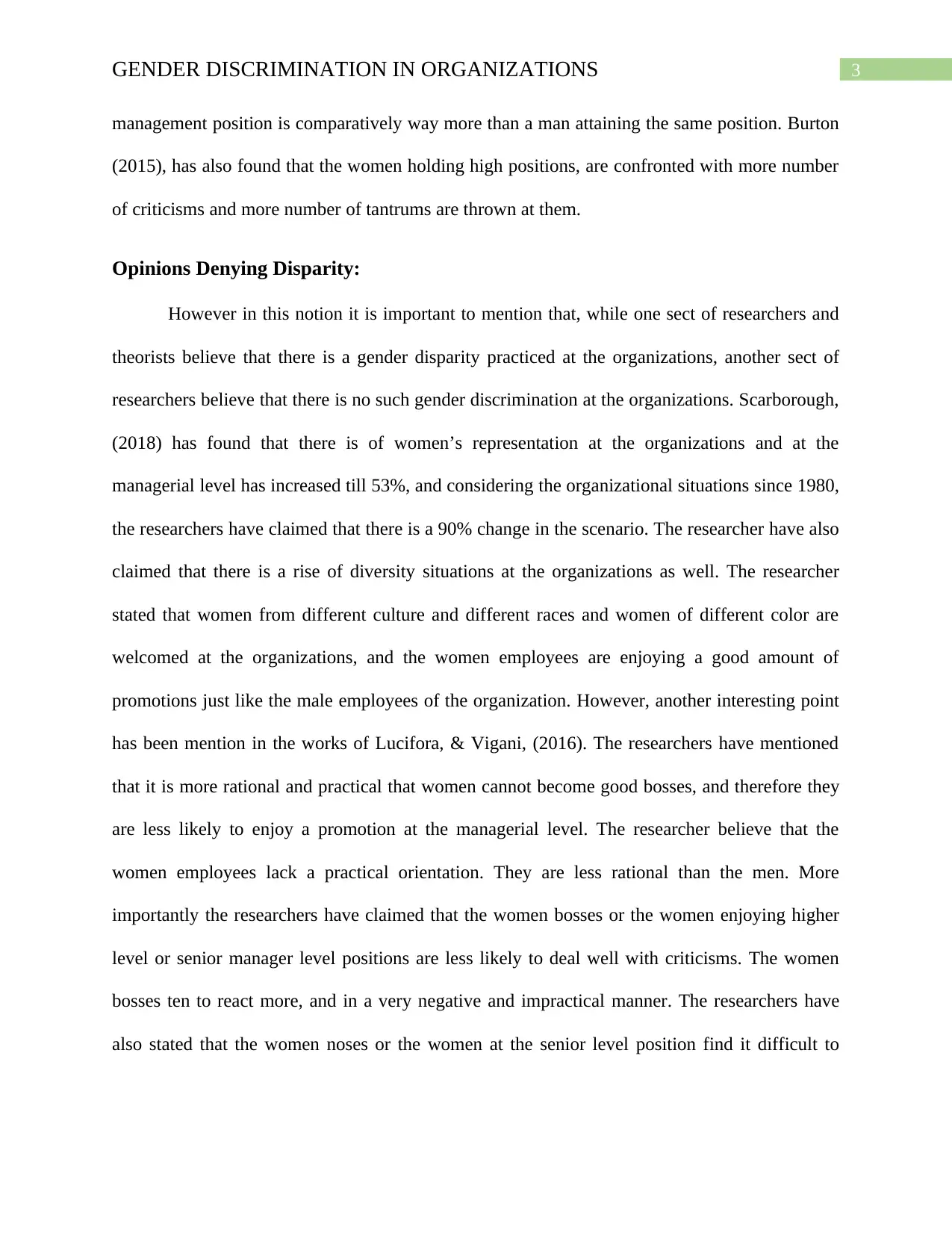
3GENDER DISCRIMINATION IN ORGANIZATIONS
management position is comparatively way more than a man attaining the same position. Burton
(2015), has also found that the women holding high positions, are confronted with more number
of criticisms and more number of tantrums are thrown at them.
Opinions Denying Disparity:
However in this notion it is important to mention that, while one sect of researchers and
theorists believe that there is a gender disparity practiced at the organizations, another sect of
researchers believe that there is no such gender discrimination at the organizations. Scarborough,
(2018) has found that there is of women’s representation at the organizations and at the
managerial level has increased till 53%, and considering the organizational situations since 1980,
the researchers have claimed that there is a 90% change in the scenario. The researcher have also
claimed that there is a rise of diversity situations at the organizations as well. The researcher
stated that women from different culture and different races and women of different color are
welcomed at the organizations, and the women employees are enjoying a good amount of
promotions just like the male employees of the organization. However, another interesting point
has been mention in the works of Lucifora, & Vigani, (2016). The researchers have mentioned
that it is more rational and practical that women cannot become good bosses, and therefore they
are less likely to enjoy a promotion at the managerial level. The researcher believe that the
women employees lack a practical orientation. They are less rational than the men. More
importantly the researchers have claimed that the women bosses or the women enjoying higher
level or senior manager level positions are less likely to deal well with criticisms. The women
bosses ten to react more, and in a very negative and impractical manner. The researchers have
also stated that the women noses or the women at the senior level position find it difficult to
management position is comparatively way more than a man attaining the same position. Burton
(2015), has also found that the women holding high positions, are confronted with more number
of criticisms and more number of tantrums are thrown at them.
Opinions Denying Disparity:
However in this notion it is important to mention that, while one sect of researchers and
theorists believe that there is a gender disparity practiced at the organizations, another sect of
researchers believe that there is no such gender discrimination at the organizations. Scarborough,
(2018) has found that there is of women’s representation at the organizations and at the
managerial level has increased till 53%, and considering the organizational situations since 1980,
the researchers have claimed that there is a 90% change in the scenario. The researcher have also
claimed that there is a rise of diversity situations at the organizations as well. The researcher
stated that women from different culture and different races and women of different color are
welcomed at the organizations, and the women employees are enjoying a good amount of
promotions just like the male employees of the organization. However, another interesting point
has been mention in the works of Lucifora, & Vigani, (2016). The researchers have mentioned
that it is more rational and practical that women cannot become good bosses, and therefore they
are less likely to enjoy a promotion at the managerial level. The researcher believe that the
women employees lack a practical orientation. They are less rational than the men. More
importantly the researchers have claimed that the women bosses or the women enjoying higher
level or senior manager level positions are less likely to deal well with criticisms. The women
bosses ten to react more, and in a very negative and impractical manner. The researchers have
also stated that the women noses or the women at the senior level position find it difficult to
Paraphrase This Document
Need a fresh take? Get an instant paraphrase of this document with our AI Paraphraser
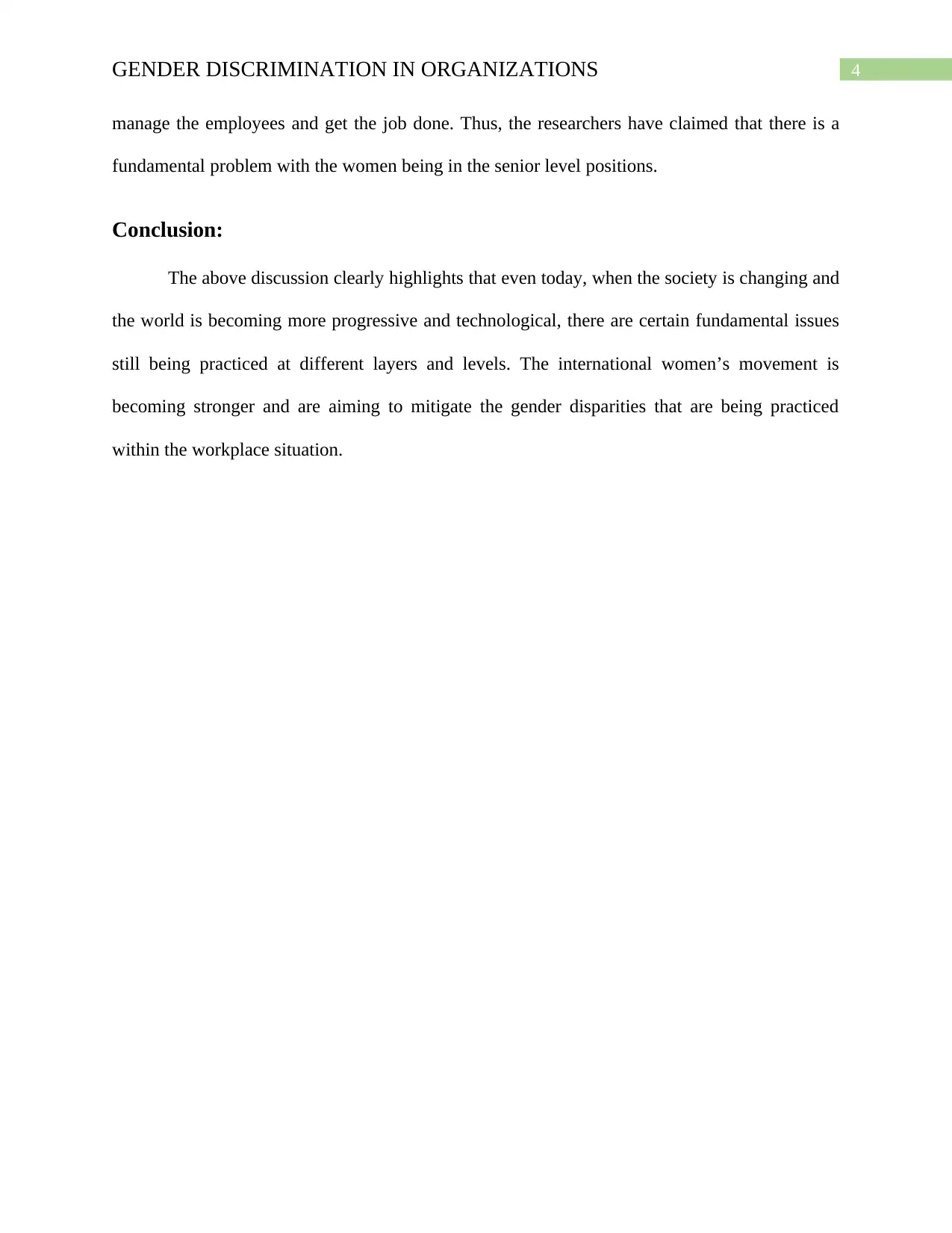
4GENDER DISCRIMINATION IN ORGANIZATIONS
manage the employees and get the job done. Thus, the researchers have claimed that there is a
fundamental problem with the women being in the senior level positions.
Conclusion:
The above discussion clearly highlights that even today, when the society is changing and
the world is becoming more progressive and technological, there are certain fundamental issues
still being practiced at different layers and levels. The international women’s movement is
becoming stronger and are aiming to mitigate the gender disparities that are being practiced
within the workplace situation.
manage the employees and get the job done. Thus, the researchers have claimed that there is a
fundamental problem with the women being in the senior level positions.
Conclusion:
The above discussion clearly highlights that even today, when the society is changing and
the world is becoming more progressive and technological, there are certain fundamental issues
still being practiced at different layers and levels. The international women’s movement is
becoming stronger and are aiming to mitigate the gender disparities that are being practiced
within the workplace situation.
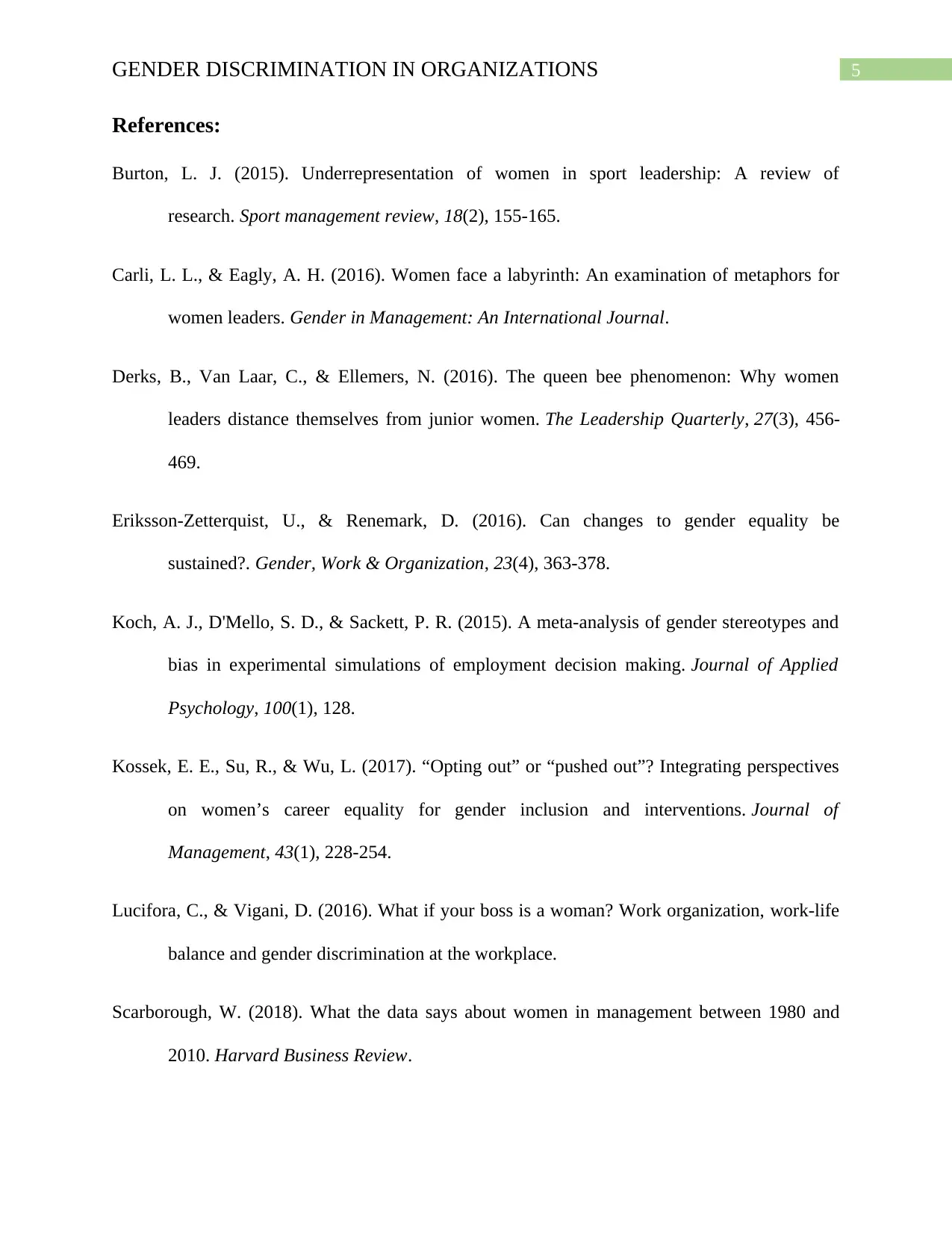
5GENDER DISCRIMINATION IN ORGANIZATIONS
References:
Burton, L. J. (2015). Underrepresentation of women in sport leadership: A review of
research. Sport management review, 18(2), 155-165.
Carli, L. L., & Eagly, A. H. (2016). Women face a labyrinth: An examination of metaphors for
women leaders. Gender in Management: An International Journal.
Derks, B., Van Laar, C., & Ellemers, N. (2016). The queen bee phenomenon: Why women
leaders distance themselves from junior women. The Leadership Quarterly, 27(3), 456-
469.
Eriksson‐Zetterquist, U., & Renemark, D. (2016). Can changes to gender equality be
sustained?. Gender, Work & Organization, 23(4), 363-378.
Koch, A. J., D'Mello, S. D., & Sackett, P. R. (2015). A meta-analysis of gender stereotypes and
bias in experimental simulations of employment decision making. Journal of Applied
Psychology, 100(1), 128.
Kossek, E. E., Su, R., & Wu, L. (2017). “Opting out” or “pushed out”? Integrating perspectives
on women’s career equality for gender inclusion and interventions. Journal of
Management, 43(1), 228-254.
Lucifora, C., & Vigani, D. (2016). What if your boss is a woman? Work organization, work-life
balance and gender discrimination at the workplace.
Scarborough, W. (2018). What the data says about women in management between 1980 and
2010. Harvard Business Review.
References:
Burton, L. J. (2015). Underrepresentation of women in sport leadership: A review of
research. Sport management review, 18(2), 155-165.
Carli, L. L., & Eagly, A. H. (2016). Women face a labyrinth: An examination of metaphors for
women leaders. Gender in Management: An International Journal.
Derks, B., Van Laar, C., & Ellemers, N. (2016). The queen bee phenomenon: Why women
leaders distance themselves from junior women. The Leadership Quarterly, 27(3), 456-
469.
Eriksson‐Zetterquist, U., & Renemark, D. (2016). Can changes to gender equality be
sustained?. Gender, Work & Organization, 23(4), 363-378.
Koch, A. J., D'Mello, S. D., & Sackett, P. R. (2015). A meta-analysis of gender stereotypes and
bias in experimental simulations of employment decision making. Journal of Applied
Psychology, 100(1), 128.
Kossek, E. E., Su, R., & Wu, L. (2017). “Opting out” or “pushed out”? Integrating perspectives
on women’s career equality for gender inclusion and interventions. Journal of
Management, 43(1), 228-254.
Lucifora, C., & Vigani, D. (2016). What if your boss is a woman? Work organization, work-life
balance and gender discrimination at the workplace.
Scarborough, W. (2018). What the data says about women in management between 1980 and
2010. Harvard Business Review.
⊘ This is a preview!⊘
Do you want full access?
Subscribe today to unlock all pages.

Trusted by 1+ million students worldwide
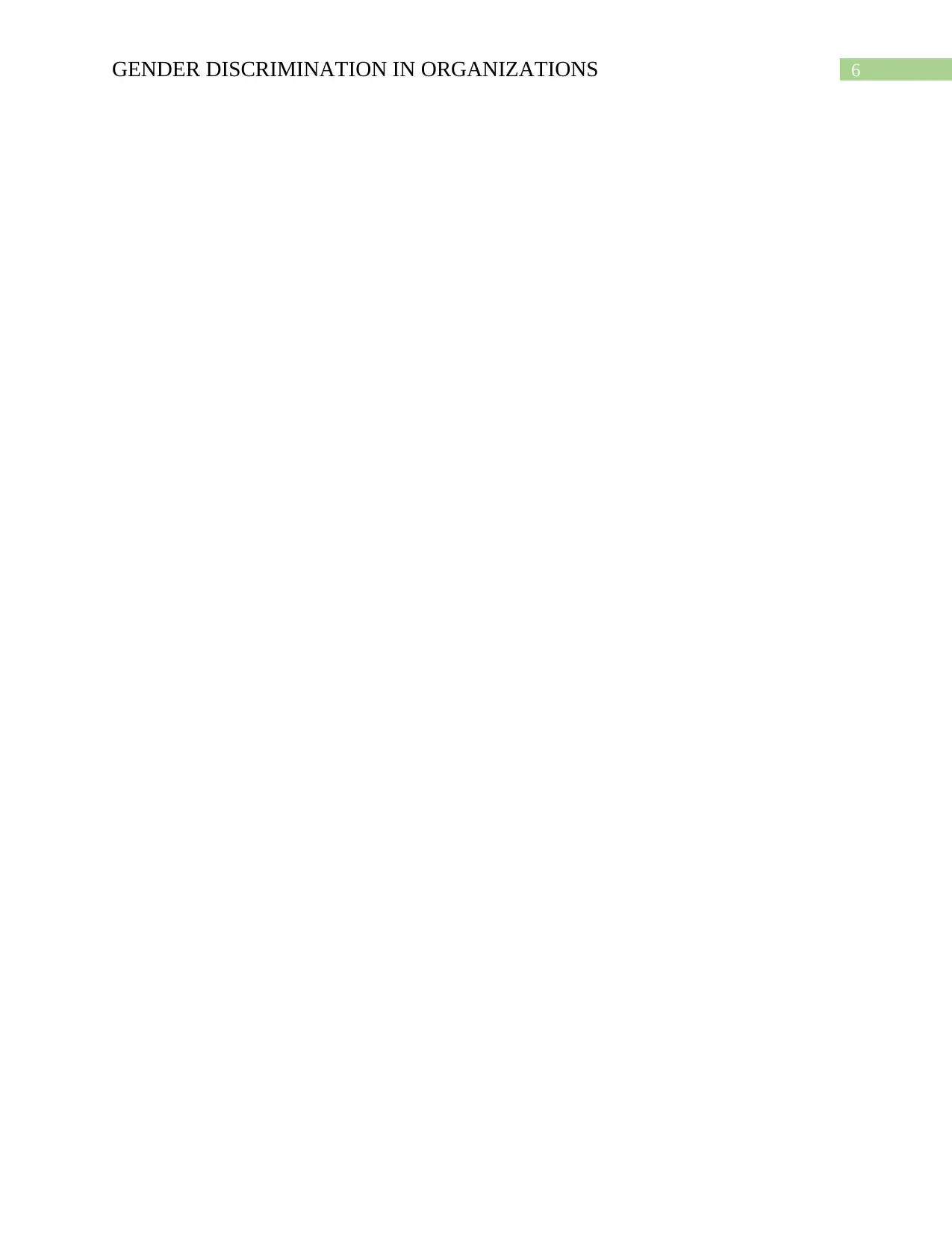
6GENDER DISCRIMINATION IN ORGANIZATIONS
1 out of 7
Related Documents
Your All-in-One AI-Powered Toolkit for Academic Success.
+13062052269
info@desklib.com
Available 24*7 on WhatsApp / Email
![[object Object]](/_next/static/media/star-bottom.7253800d.svg)
Unlock your academic potential
Copyright © 2020–2025 A2Z Services. All Rights Reserved. Developed and managed by ZUCOL.





